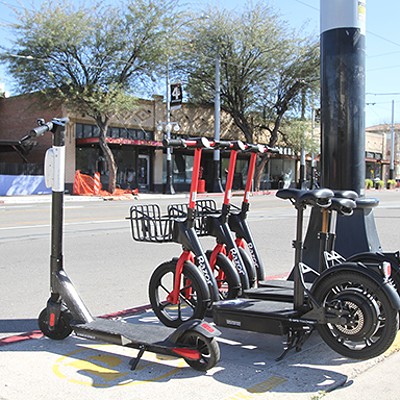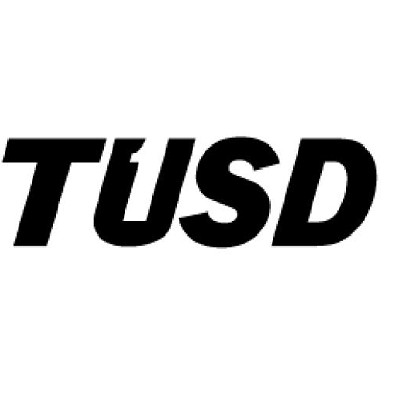Now, one year after voters rejected the plan by a 2-1 margin, Walkup has found a Plan B after all: a regional authority to tackle the metro area's transportation system. He's pushing for a UA study to determine "a fair and just way to administer transportation funding in this region."
Walkup's critics gripe that the mayor has punted the ball.
"Bob isn't saying what the transportation authority would do," says Steve Farley of Tucsonans for Sensible Transportation, a group that hopes to put a light-rail initiative on the city's November ballot. "Why the hell should we spend all that time trying to set up a system which might then figure out what to do? Why not figure out what to do and do it now?"
The underlying problem for Walkup: There's not nearly enough money to tackle Tucson's steep transportation bills. Officials estimate that the total cost just to meet minimum standards for residential and arterial roads, streetlights and sidewalks runs somewhere in the neighborhood of $500 million. Roughly $200 million of that figure is needed just to repair neighborhood streets, which have been long neglected. And the longer the city fails to maintain them, the higher the bill climbs. If pavement is undergoes routine maintenance every 10 years, it costs 89 cents per square yard. Let that slide to every 24 years, and the cost jumps to $7.72 per square yard, according to city officials.
Jim Glock, the longtime deputy director who's now in the driver's seat at the Tucson Transportation Department, says one priority is restoring the community's trust in the department. To that end, he's ordered a review of the organization to win national accreditation from American Public Works Association.
"Given that there's not a lot of money for building roads or expanding buses, I can work on some organizational improvements," says Glock.
With the community's growing congestion, building faith remains a tall order. And as the city burns through its reserve transportation funding to pay off past bonds, money for major widening projects could become even tighter.
Once the city completes the expansion of Campbell Avenue between Elm Street and Grant Road, the only other major projects Glock foresees are building a new Fourth Avenue underpass, improving Harrison Road between Speedway Boulevard and Old Spanish Trail, and a expanding a short stretch of Wetmore Road west of Oracle Road. (That last project has stalled because the car dealers at the Auto Mall have rejected efforts to form an improvement district to pay part of the bill.)
The city has also asked county officials to fork over Pima County's share of several promised projects within the city limits, including widening Broadway Boulevard just east of downtown and Grant Road east of Interstate 10. But County Administrator Chuck Huckelberry, beset by cost overruns and accusations of graft regarding the 1997 bonds that included those projects, says the county won't provide that money until the city comes up with its matching share.
"With our cash crunch right now, we're not necessarily in a position to make up those differences," says Glock.
Whatever else happens, city officials say they don't foresee construction of a long-planned, much-maligned grade-separated intersection at Campbell Avenue and Grant Road. Walkup says GSIs, which allow one street to tunnel beneath another, may be an alternative on the city's perimeter, where he hopes a loop road will one day allow faster traffic; Glock says he thinks one could still be built at the intersection of Grant, Kolb and Tanque Verde roads.
But without more funding, pricey intersections remain out of reach, as do many other improvements. The Pima Association of Governments' wish list of projects suggests that local jurisdictions, including Tucson, need at least $8.4 billion for transportation projects through 2025. Officials estimate that with present taxes, there will only be $6.6 billion available, leaving a $1.8 billion shortfall.
Those projects include an improved mass transit system, which has its own present funding woes. With rising labor and gas costs, the price of running Sun Tran continues to climb faster than ridership, which remains barely above the minimum 14.5 million annual rides required under a air-quality agreement with the federal Environmental Protection Agency, according to Glock.
Expansion of the system to include more late-night and weekend routes, as well as service to areas such as Rita Ranch, is impossible without more funding, he adds.
The only shot at boosting public transit in the short run appears to be persuading Tucson voters to support a light-rail initiative that Tucsonans for Sensible Transportation--operating as the political committee Citizens for a Sensible Transportation Solution--hope to get on the November ballot.
Voters will be asked to boost the sales tax three-tenths of a cent and impose a 4 percent construction sales tax. Farley hopes the federal government will provide the remainder of the funds necessary for building and operating the system.
Along with spending 20 percent of the new dollars on repair of residential streets and 10 percent on building sidewalks, the plan would create a 13-mile light-rail system tied into a improved bus system that would include shorter waits at stops for riders and longer hours of operation.
One train would run east from downtown's Ronstadt Transit Center, moving along Sixth Street past the University of Arizona before jogging south down Country Club Road over to Broadway Boulevard, where it would continue east past both major malls all the way to Prudence Road. The second route would travel south along South Sixth Avenue to the Laos Transit Center at Irvington Road. (For complete details, see the group's web site, www.tucsonlightrail.org)
The group has collected roughly 10,000 signatures to put its plan on the ballot, with another 187 volunteers out collecting signatures, according to Farley. The group must deliver 12,777 valid signatures by July 3.
"It's coming down the to the wire, but we're pushing really hard," says Farley, who is spending his evenings collecting signatures at midtown's Casa Video. "People are so appreciative. They ask, 'Why the hell haven't we done this already?'"
















